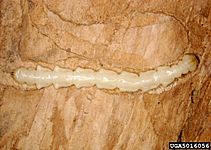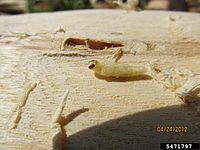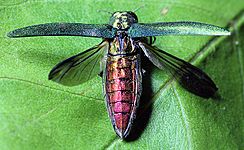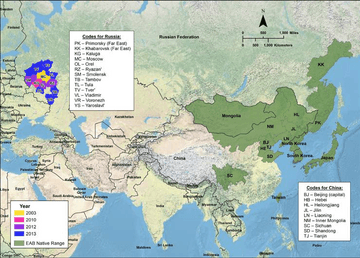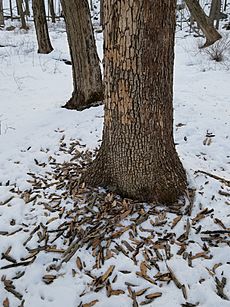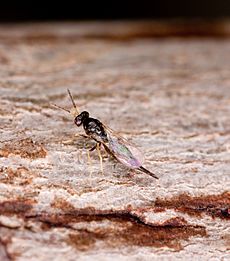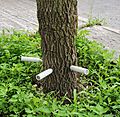Emerald ash borer facts for kids
Quick facts for kids Emerald ash borer |
|
|---|---|
 |
|
| Scientific classification | |
| Genus: |
Agrilus
|
| Species: |
planipennis
|
| Synonyms | |
|
|
The emerald ash borer (Agrilus planipennis), also called EAB, is a shiny green beetle. It comes from north-eastern Asia. This beetle loves to eat ash trees.
Female EABs lay their eggs in the cracks of ash tree bark. The young beetles, called larvae, then feed under the bark. They grow into adult beetles in one to two years. In Asia, where they come from, there are usually not many EABs. They do not harm the trees much there.
But outside of Asia, the EAB is an invasive species. This means it spreads easily and causes a lot of damage. It is very harmful to ash trees in Europe and North America. Before it was found in North America, people did not know much about this beetle. So, most of the research on EAB has happened in North America. Local governments are trying to stop its spread. They watch where it goes, plant different kinds of trees, use insecticides, and try biological control methods.
Contents
History of the Emerald Ash Borer
A French priest and scientist named Armand David found a specimen of this beetle. He collected it during his travels in China in the 1860s and 1870s. He found the beetle in Beijing. Then he sent it to France.
In 1888, a scientist named Léon Fairmaire wrote the first short description of Agrilus planipennis. This was published in a science magazine. Later, in 1930, another scientist named Jan Obenberger described the same beetle. He named it Agrilus marcopoli, not knowing Fairmaire had already described it.
What the Emerald Ash Borer Looks Like
Adult EABs are usually bright metallic green. They are about 8.5 millimeters (0.33 in) long and 1.6 millimeters (0.063 in) wide. Their wing covers, called Elytra, are often a darker green. They can also have a copper color.
The emerald ash borer is the only Agrilus beetle in North America with a bright red upper belly. You can see this when its wings are spread. This beetle also has a small spine at the end of its body. Its antennae have small teeth, starting from the fourth segment. When they damage trees, they leave winding tracks under the bark. These tracks are sometimes visible. People sometimes mistake other beetles for the EAB.
Life Cycle of the Emerald Ash Borer
The emerald ash borer's life cycle can take one or two years. This depends on when the eggs are laid. It also depends on the tree's health and the temperature.
Eggs hatch in about two weeks. The larval stage is the longest part of their life. Larvae bore through the bark. They start feeding in the outer part of the tree's inner bark. This feeding lasts for at least 300 warm days.
Adult beetles start to come out of trees in late spring. This happens after 400–500 warm days above 10 °C (50 °F). Most adults come out around 1,000 warm days.
After they come out, adults eat ash leaves for about a week. They do this in the tree's top branches, called the canopy. They do not eat enough to cause much damage to the leaves. Males fly around trees and find females by looking at them. They then drop onto the female to mate.
A female EAB can live for about six weeks. She can lay about 40–70 eggs. But females that live longer can lay up to 200 eggs.
Eggs are laid in cracks or flakes of bark. They hatch about two weeks later. The eggs are about 0.6 to 1.0 millimeter (0.02 to 0.04 in) wide. They are white at first. Then they turn reddish-brown if they are going to hatch.
After hatching, the larvae chew through the bark. They go into the inner bark and wood. There, they feed and grow. The EAB has four larval stages. As they feed, larvae make long, winding tunnels. These tunnels are called galleries. Full-grown larvae are 26 to 32 millimeters (1.0 to 1.3 in) long.
In the fall, mature larvae dig small rooms. These rooms are about 1.25 centimeters (0.49 in) deep into the wood or outer bark. They then fold into a J-shape. These J-shaped larvae become shorter. They turn into pupae and then adults the next spring.
To leave the tree, adults chew D-shaped holes through the bark. These holes are a clear sign of EAB. Younger larvae can stay in their tunnels over winter. They might need another summer of feeding. Then they overwinter again and come out as adults the following spring. This two-year life cycle is more common in cold places, like European Russia.
Where the Emerald Ash Borer Lives
The emerald ash borer naturally lives in cool parts of north-eastern Asia. This includes countries like Russia, Mongolia, northern China, Japan, and Korea.
The beetle is an invasive species in North America. It has a main population in Michigan and nearby states and provinces. Outside this main area, the populations are more scattered. It has spread north to Ontario, south to northern Louisiana, west to Colorado, and east to New Brunswick.
In eastern Europe, the beetle was found in Moscow, Russia, in 2003. From 2003 to 2016, this population spread west. It moved up to 40 km (25 mi) each year. It is expected to reach central Europe between 2031 and 2036. By 2019, it had not been found in the European Union. But it had already spread to far eastern Ukraine from Russia.
Trees the Emerald Ash Borer Attacks
In its native home, the EAB is not a big problem for trees. There are usually not enough beetles to kill healthy trees. In China, it attacks native ash trees like F. chinensis, F. mandshurica, and F. rhynchophylla. In Japan, it also attacks F. japonica and F. lanuginosa.
The emerald ash borer mainly attacks and badly damages ash trees. In North America, this includes green ash (Fraxinus pennsylvanica), black ash (Fraxinus nigra), white ash (Fraxinus americana), and blue ash (Fraxinus quadrangulata). In Europe, the main ash tree it attacks is Fraxinus excelsior.
Some ash trees are more likely to be attacked than others. This can depend on how attractive their smells are to adult beetles. It also depends on how well larvae can handle certain chemicals in the trees. The EAB has also been found in white fringe trees in North America. These are not ash trees. But it is not clear if these trees were healthy or already sick when the EAB attacked them.
Adult EABs prefer to lay eggs on ash trees that are stressed or growing in open areas. But they will also lay eggs on healthy trees among other tree types. Ash trees planted close together, like in parks or neighborhoods, are more likely to be attacked. This is more common than for single trees or trees in mixed forests.
Ash trees in cities often face more stress. This includes packed soil, not enough water, heat from cities, road salt, and pollution. These stresses can make them weaker against the EAB. Also, many ash trees in cities come from only a few types. This means they are not very different from each other genetically. Young trees with bark between 1.5 millimeters (0.059 in) and 5 millimeters (0.20 in) thick are preferred. Both male and female beetles use smells from leaves and bark to find trees.
The damage to trees happens when the larvae feed. Their winding feeding tunnels cut off the flow of water and nutrients. This effectively "girdles" or kills the tree. The tree can no longer get enough water and food to its leaves to survive. Girdled ash trees often try to grow new shoots from their stumps. Stressed trees might also produce more seeds than usual as a last effort.
Why the Emerald Ash Borer is a Problem
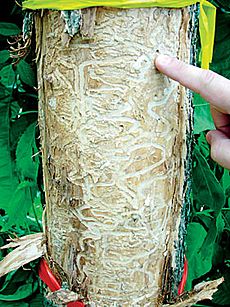
Outside its native home, the emerald ash borer is an invasive species. It causes huge damage to ash trees where it has been introduced. Before the EAB was found in North America, little was known about it. Most research on its life and habits has happened in North America. The insect was first found in Canton, Michigan, near Detroit, in 2002. But it might have been in the U.S. since the late 1980s. People think it came from overseas in shipping materials, like wooden crates.
In its native range, there are things that keep EAB numbers low. These include resistant trees, predators, and tiny parasitoid wasps. Without these things, EAB numbers can quickly grow very high. Once an area is infested, almost all ash trees are expected to die within 10 years. This happens if nothing is done to control the beetles. Every type of North American ash tree can be attacked by the EAB. North American ash trees planted in China also die easily from EAB. But some Chinese ash trees are resistant.
Green ash and black ash trees are the EAB's favorite. White ash trees also die quickly. But this usually happens after most green and black ash trees are gone. Blue ash trees seem to be more resistant to the EAB. This is because their leaves have a lot of a chemical called tannin. This makes the leaves taste bad to the insect. Most Asian ash trees have this defense. But American ash trees, except for blue ash, do not.
Scientists have looked at "lingering ash" trees. These are trees that survived EAB attacks with little damage. They hope to use these trees to grow new, resistant ash trees. Many of these lingering ash trees had unusual traits that might help them resist the EAB. Besides tannins, Asian ash trees also have natural ways to fight off EAB larvae. They can repel, trap, and kill them. American ash trees might have similar defenses. But they do not seem to know when they are being attacked.
Many of the special predators and wasps that kept EAB numbers low in Asia were not in North America. Predators and wasps native to North America do not control the EAB enough. So, EAB populations keep growing. Birds like woodpeckers eat EAB larvae. But no American animals seem to eat the adult beetles.
EAB populations can spread between 2.5 to 20 km (1.6 to 12.4 mi) per year. They mainly spread by flying. They also spread when people move ash wood products, like firewood or young trees. This lets them reach new areas and start new groups of beetles far from the main infestation.
Other things can slow their spread. Very cold winter temperatures, around −38 °C (−36 °F), can stop them from spreading further. Overwintering EABs can survive down to about −30 °C (−22 °F). This is because they have natural antifreeze chemicals in their bodies. The tree bark also provides insulation. Larvae can also survive high heat, up to 53 °C (127 °F).
Like ash trees grown for landscaping, the EAB population in North America likely came from one group of insects from central China. This means they do not have much genetic diversity.
North American predators and wasps can sometimes kill many EABs. But generally, they do not control the population enough. The number of EABs killed by native woodpeckers changes a lot. Some wasps, like Atanycolus cappaerti, can kill many EABs. But overall, this control is usually low.
The United States Department of Agriculture (USDA) stopped all EAB quarantine activities in the United States on January 14, 2021. This was because they were not working well. Other methods, especially #Biological control, will be used instead.
Impacts on Nature and Money
The emerald ash borer threatens all ash trees in North America. It has already killed tens of millions of ash trees. It could kill most of the 8.7 billion ash trees across North America. The EAB kills young trees before they are old enough to produce seeds, which is usually at 10 years old.
In both North America and Europe, losing ash trees can cause problems. More invasive plants might grow. Soil nutrients can change. And animals that eat ash trees can be affected.
The damage and efforts to control the EAB have affected many groups. These include businesses that sell ash trees or wood, property owners, and local governments. Quarantines can stop the movement of ash trees and wood products. But the costs are very high for cities and towns. This is because of the cost to treat or remove dying trees. Property values can also go down.
Homeowners or local governments often have to pay to manage these trees. For cities, removing many dead or infested trees at once is very expensive. So, slowing down how fast trees die can help. This is done by removing known infested trees and treating trees with insecticides. This gives local governments more time to plan, remove, and replace trees. This strategy saves money. It would cost $10.7 billion in urban areas of 25 states over 10 years. But removing and replacing all ash trees at once in these areas would cost $25 billion. Some estimates say removal alone could cost $20-60 billion. Some cities, like Minneapolis, have many ash trees. More than 20% of their city trees are ash.
How People Watch for the Emerald Ash Borer
In places where the EAB has not been found yet, people use surveys to look for new infestations. They visually check ash trees for signs of EAB damage. They also hang traps in trees. These traps are often purple or green, colors that attract the EAB.
These traps can also have special smells, called pheromones, that attract mostly male beetles. Sometimes, trees are "girdled" to act as trap trees. This means a ring of bark is removed to stress the tree. Stressed trees attract female EABs to lay eggs in the spring. In the fall, the bark can be removed to look for larvae.
If EAB is found, an area is often put under a quarantine. This stops infested wood from being moved and starting new infestations. Then, other steps are taken in the area. These steps slow down the beetle population. They aim to reduce beetle numbers, stop them from reproducing, and lower the number of ash trees.
Government groups in the U.S. and Canada use a native wasp called Cerceris fumipennis to find EAB. These female wasps hunt other jewel beetles, including the EAB if it is there. The wasps sting the beetles to stun them. Then they carry them back to their bur burrows in the ground. The beetles are stored there for the wasp larvae to eat. Volunteers catch the wasps as they return with beetles. This helps them find out if EAB is present. This method is called biological surveillance. It is not biological control, because the wasps do not seem to greatly reduce EAB numbers.
How People Manage the Emerald Ash Borer
In areas where the EAB is not native and is causing problems, people use different methods. These include quarantines, removing infested trees, using insecticides, and biological control. These methods help reduce damage to ash trees.
Quarantine and Tree Removal
Once EAB is found, government agencies usually put quarantines in place. These rules stop people from moving ash firewood or live ash plants outside the area. This is not allowed without special permits. These permits show the material has been checked or treated. Treatment might include heat or wood chipping. This makes sure no live EABs are in the bark or inner bark.
In cities, trees are often removed when an infestation is found. This helps lower the number of EABs. It also reduces the chance of them spreading further. City ash trees are usually replaced with other types of trees. These might be maple, oak, or linden trees. This limits the food sources for the EAB. In rural areas, trees can be cut for lumber or firewood. This reduces the number of ash trees. But quarantines might still apply to this wood, especially if it could be infested.
Experts suggest planting different kinds of trees to replace removed ash trees. In the past, people often planted too many ash trees. This created "monocultures," where only one type of tree grew. This was a big reason why the EAB caused so much damage. Planting many different species helps keep city forests healthy. Scientists suggest choosing unique trees. These could include the pawpaw, yellowwood, Franklin tree, Kentucky coffeetree, Osage orange, sourwood, and baldcypress.
Insecticides
Insecticides are chemicals used to kill insects. Some common ones used against EAB have active ingredients like azadirachtin, imidacloprid, emamectin benzoate, and dinotefuran. Dinotefuran and imidacloprid are "systemic." This means they are absorbed into the tree. They can work for one to three years, depending on the product.
Insecticides are usually only used in cities for valuable trees near an infestation. Ash trees are often treated by injecting the chemical directly into the tree. Or, the chemical can be poured onto the soil around the tree. Some insecticides can only be used by trained professionals. Even with insecticide treatments, damage from EAB can continue to increase over time. Insecticide treatments are not practical for large forest areas outside of cities.
Biological Control
Scientists looked for natural enemies of the EAB in its native home in Asia. They hoped to find tiny wasps that only attack the EAB. These wasps could then be released in North America to control the beetle.
Three species of wasps from China were approved for release by the USDA in 2007. Canada approved them in 2013. These wasps are Spathius agrili, Tetrastichus planipennisi, and Oobius agrili. Another wasp, Spathius galinae, was approved in 2015.
The first three species have been found attacking EAB larvae one year after being released. This shows they survived the winter. But how well they established varied by species and location. Tetrastichus planipennisi and Oobius agrili have established well. Their populations have grown in Michigan since 2008. Spathius agrili has not established as well in North America. This might be because there are not enough EAB larvae when the adult wasps come out in spring. It also might not handle cold very well. It seems to do better in areas south of the 40th parallel.
The USDA is also looking into using Beauveria bassiana. This is a fungus that can make insects sick. They hope to use it to control the EAB along with the wasps.
Images for kids
See also
 In Spanish: Agrilus planipennis para niños
In Spanish: Agrilus planipennis para niños


